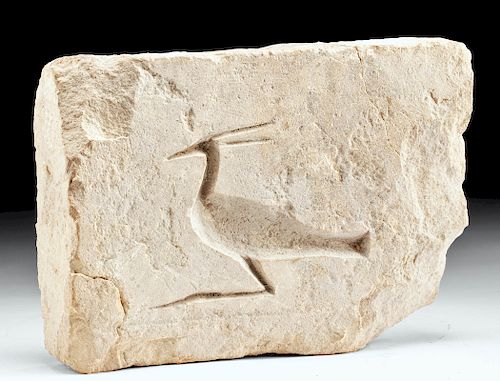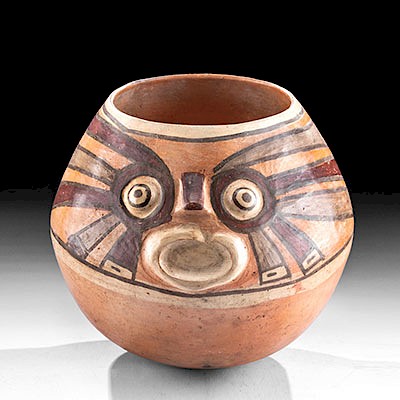Egyptian Ptolemaic Limestone Relief Plaque of Heron
Lot 6a
About Seller
Artemis Gallery
686 S Taylor Ave, Ste 106
Louisville, CO 80027
United States
Selling antiquities, ancient and ethnographic art online since 1993, Artemis Gallery specializes in Classical Antiquities (Egyptian, Greek, Roman, Near Eastern), Asian, Pre-Columbian, African / Tribal / Oceanographic art. Our extensive inventory includes pottery, stone, metal, wood, glass and textil...Read more
Categories
Estimate:
$2,500 - $5,000
Absentee vs Live bid
Two ways to bid:
- Leave a max absentee bid and the platform will bid on your behalf up to your maximum bid during the live auction.
- Bid live during the auction and your bids will be submitted real-time to the auctioneer.
Bid Increments
| Price | Bid Increment |
|---|---|
| $0 | $25 |
| $300 | $50 |
| $1,000 | $100 |
| $2,000 | $250 |
| $5,000 | $500 |
| $10,000 | $1,000 |
| $20,000 | $2,500 |
| $50,000 | $5,000 |
| $100,000 | $10,000 |
| $200,000 | $20,000 |
About Auction
By Artemis Gallery
Dec 5, 2019
Set Reminder
2019-12-05 10:00:00
2019-12-05 10:00:00
America/New_York
Bidsquare
Bidsquare : Ancient / Ethnographic - Holiday Edition
https://www.bidsquare.com/auctions/artemis-gallery/ancient-ethnographic---holiday-edition-4710
What to give this holiday season? Ancient & Ethnographic Art of course! Our special Holiday auction features hundreds of unique finds from all over the world. Artemis Gallery info@artemisgallery.com
What to give this holiday season? Ancient & Ethnographic Art of course! Our special Holiday auction features hundreds of unique finds from all over the world. Artemis Gallery info@artemisgallery.com
- Lot Description
Egypt, Ptolemaic Period, ca. 305 to 30 BCE. Carved from a single piece of limestone, this impressive plaque depicts a crested bird, likely a heron or egret, carved in negative relief. Herons have resided in the Nile Delta as well as along the Red Sea year round. These magnificent birds, with their fanciful crests, were clearly beloved by the ancient Egyptians, as images of the birds were quite prevalent. See a drawing of an egret on a funerary papyrus found by the Metropolitan Museum of Art's excavators in Thebes in 1929 (object number 30.3.32). According to Met scholar Dorothea Arnold, "The ancient Egyptians believed that their king ascended to heaven in the form of the crested bird, and artists also often depicted the legendary phoenix as a heron. In every- day life these avian experts in fishing were used by fowlers as decoys to lure other birds into the nets." ("An Egyptian Bestiary" - Metropolitan Museum of Art Bulletin Spring 1995, p. 31) Size: 1.75" L x 7.25" W x 5.25" H (4.4 cm x 18.4 cm x 13.3 cm)
Please note that an old collection label attached to the underside of this piece reads in part, "Limestone relief plaque depicting an Ibis, the bird that the Egyptians associated with the god Thoth who was the scribe of the gods and the moon deity, patron of writing, mathematics, and language …" However, the bird rendered on this plaque differs in appearance from an ibis in that the beak is not hooked and the bird possesses an ornamental crest akin to a heron or egret.
Provenance: private J.H. collection, Beaverton, Oregon, USA, acquired in the 1990s; ex-Tom Cederlind collection, Portland, Oregon, USA
All items legal to buy/sell under U.S. Statute covering cultural patrimony Code 2600, CHAPTER 14, and are guaranteed to be as described or your money back.
A Certificate of Authenticity will accompany all winning bids.
We ship worldwide and handle all shipping in-house for your convenience.
#150048A section from a larger relief. Repaired from 3 to 6 large pieces, but very well done. Surface covered with mineral deposits. Minor nicks to peripheries of the back and chest of the egret relief.Condition
- Shipping Info
-
All shipping is handled in-house for your convenience. Your invoice from Artemis Gallery will include shipping calculation instructions. If in doubt, please inquire BEFORE bidding for estimated shipping costs for individual items.
-
- Buyer's Premium



 EUR
EUR CAD
CAD AUD
AUD GBP
GBP MXN
MXN HKD
HKD CNY
CNY MYR
MYR SEK
SEK SGD
SGD CHF
CHF THB
THB














